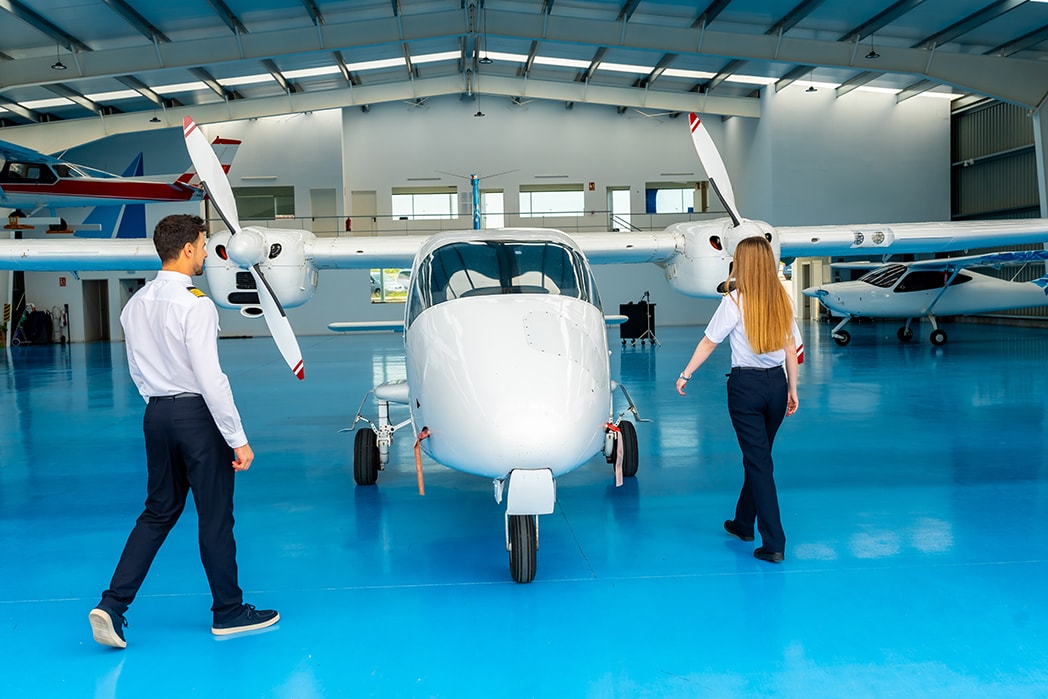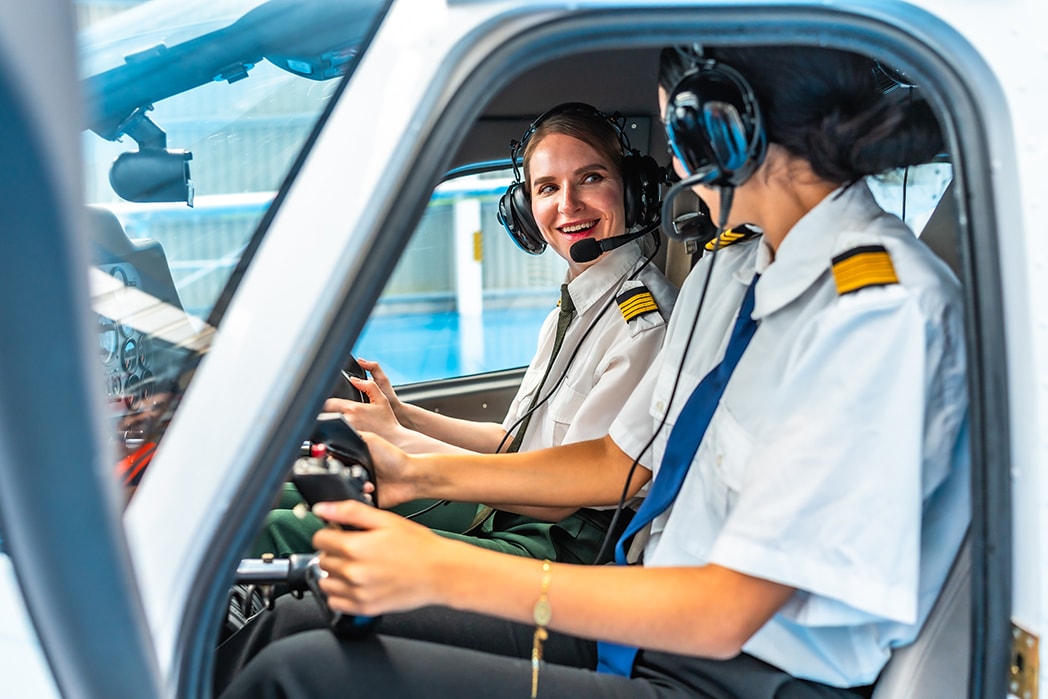Part 141 vs 61: Key Differences in Flight Training
Aug 13, 2025
If you’re deciding between Part 141 vs 61 flight training you need to know the differences. Both are FAA approved and operate under federal aviation regulations but have different structures and are suited for different types of students.
This article will break down the key differences in Part 141 vs 61 so you can decide which training program is best for you.
Key Takeaways
-
Part 61 flight training is flexible and personalized, good for hobbyists and those with busy schedules, while Part 141 is structured and standardized for aspiring commercial pilots.
-
The main differences between Part 61 and Part 141 are curriculum structure, FAA oversight and minimum flight hour requirements with Part 141 requiring fewer hours due to a structured training program.
-
When choosing a flight training program consider your career goals, learning style and funding options as Part 141 schools have more financial aid than Part 61.
Overview of Part 61 and Part 141 Flight Training

Aviation enthusiasts have two choices when it comes to flight training: Part 61 and Part 141. Both are approved by the Federal Aviation Administration (FAA) and operate under federal regulations so you know you’ll get great training.
Part 61 schools are flexible, you can work around your schedule. Part 141 schools are more structured and professional if you want to pursue a career in aviation. Knowing the difference helps you choose the right training for you.
What is Part 61?
Part 61 flight training is all about flexibility and personalization. Unlike Part 141, Part 61 allows you to progress at your own pace. Perfect for hobbyists and those with busy schedules, you can fly on weekends, after work or whenever you can. It’s a tailored learning experience.
Another big plus of Part 61 is its adaptability. Instructors can customize lesson plans to fit each student’s needs, so you get the instruction that’s right for you.
This flexibility is guided by FAA recommendations such as AC 61 98D, which supports individualized and flexible flight training approaches.
Personalized training makes getting a private pilot certificate or commercial pilot license more enjoyable and less stressful especially for those aiming to earn their private pilot license through a flexible path.
What is Part 141?
In contrast to the flexibility of Part 61, part 141 flight training is structured and professional. For those serious about a career in aviation. Key features of Part 141 flight schools are:
-
Following a mandatory, FAA approved syllabus
-
A consistent and standardized training experience
-
Helping aspiring commercial pilots meet industry standards
Part 141 training programs are for students aiming to become airline pilots or other professional aviation careers.
These programs offer a streamlined path with a clear progression through the training stages, so you can achieve your aviation goals faster and more efficiently.
Key Differences Between Part 61 and Part 141

Knowing the differences between Part 61 and Part 141 flight training helps you make an informed decision. Part 61 is flexible and personalized, Part 141 is structured and standardized.
These differences impact many areas of training including curriculum, FAA oversight and the biggest difference is in the minimum flight hour requirements.
Curriculum Structure
Curriculum structure is where Part 61 and Part 141 differ:
-
Part 61 schools do not require an FAA approved curriculum.
-
Instructors can tailor the training to each student.
-
This means a personalized training experience.
-
Lesson plans are adjusted to student progress and learning style.
Part 141 programs have a highly regulated and FAA approved syllabus which includes:
-
All students get a consistent and standardized training experience
-
A structured curriculum with specific learning objectives and course components
-
A clear path through the training stages
-
A regimented approach for consistency and compliance with FAA regulations
This is why Part 141 is best for those looking for a professional aviation career.
FAA Oversight and Standards
FAA oversight and standards are more strict in Part 141 flight training than in Part 61. Part 141 flight schools must:
-
Get approval for their curriculum
-
Pass regular inspections to ensure they meet higher operational standards
-
Use certified instructors
-
Have proper classroom facilities These make for a more controlled environment.
Part 61 training programs are less regulated:
-
Instructors have more freedom to decide the structure and quality of the training, so the environment can vary.
-
This can be good for those who want a relaxed schedule.
-
But may lack the consistency and quality control of Part 141 programs.
Minimum Flight Hours
Minimum flight time for certification is vastly different between Part 61 and Part 141. Under Part 61 a private pilot certificate requires 40 hours of flight time but in reality many students need more to be ready.
A commercial pilot license requires 250 hours of flight time which is the minimum hours required for that certificate.
Part 141 requires fewer hours due to the structured training:
-
A commercial pilot license under Part 141 requires 190 hours of flight time.
-
Fewer hours means lower overall training cost.
-
This makes Part 141 a great option for many pilots especially those who want to lower minimum flight hours.
Cost and Time Considerations
When deciding between Part 61 and Part 141 flight training, cost and time are key. The total cost and time of training can vary greatly depending on the path you choose.
Factors like the flight school’s reputation, the condition of the aircraft and the location all play into the total cost and time investment of flight training.
Training Costs
Training costs for Part 61 and Part 141 can be vastly different. Part 61 training is more expensive due to the higher flight hour requirements.
At Part 61 flight schools you can negotiate aircraft rental and instructor rates so costs can vary. You don’t have to pay for ground school which can save you even more money.
Part 141 training has a more structured pricing model which includes:
-
Lower flight hour requirements which generally means lower overall cost than Part 61.
-
Additional fees if you fall behind in your training.
-
Hourly rates for flight time and instructor fees.
This structured pricing gives you a clear idea of the financial commitment.
Training Duration
Flight training duration varies between Part 61 and Part 141:
-
Part 141 programs follow a set timetable, leading to a more predictable and consistent training duration.
-
Students typically complete their training around the same time.
-
This can be beneficial for those looking to enter the aviation industry quickly.
Part 61 training, on the other hand, offers much more flexibility part. The duration of the training can differ greatly based on the individual’s schedule and learning pace.
This adaptability helps students balance flight training with personal commitments, ideal for busy individuals.
Choosing the Right Program for Your Aviation Career

Choosing the right flight training program is a big decision that can impact your aviation career.
Consider personal and career goals, learning style and schedule when choosing between Part 61 and Part 141.
Each has its own benefits and challenges and aligning your choice with your long term goals is key to success.
Personal and Career Goals
Career goals play a big part in choosing the best training program. For example, if you want to be a commercial airline pilot, Part 141 might be the way to go as it’s structured and standardized.
This path can get you to your professional pilot goal faster and is often the preferred route for those pursuing a commercial pilot certificate.
Conversely if you’re flying for fun or have other career commitments Part 61 vs might be the way to go. Part 61 allows you to train at your own pace and fit flying lessons around your existing schedule.
Aligning your primary training program with long term goals is key to aviation career success.
Learning Preferences and Schedule
Personal learning preferences and schedules play a big part in choosing between Part 61 and Part 141.
Part 61 is perfect for people who need to balance flight training with other personal commitments. The flexible schedule allows you to progress at your own pace, it’s great for busy people.
On the other hand if you prefer a structured and disciplined learning environment Part 141 might be the way to go.
The standardized curriculum and set timetable means a consistent training experience and helps you pass stage checks and achieve your milestones faster.
Knowing your learning preferences and schedule is key to choosing the right flight training program.
Training Environment and Quality Control
Training environment and quality control differ between Part 61 and Part 141 flight schools. While Part 61 is more flexible and adaptable, 61 vs part 141 is highly regulated and standardized so the same quality of training.
Each has its pros and cons so choose what’s best for you.
Training Facilities and Resources
Part 61 is very accessible, often done at local regional airports. This accessibility allows you to find flight schools near you, making it easier to fit training into your daily life.
The flexibility in facilities and resources means Part 61 schools can adapt to your needs as a student, a personalized training environment.
Part 141 flight schools have more structured resources and facilities, dedicated classroom training and standardized syllabus.
These schools aim to provide a consistent and professional training environment, overall better learning experience. The structured facilities ensures you have the tools and resources to succeed in your training.
Instructor Quality and Consistency
Instructor quality and consistency is key in flight training. Here are the points:
-
Part 141 schools must have certified instructors, including a flight instructor.
-
Instructors must follow a structured curriculum.
-
Students are evaluated regularly before progressing.
-
Consistency breeds a reliable training environment.
-
High standards are maintained through this process.
Part 61 allows for more varied instructor quality which has its pros and cons:
-
More flexibility and personalized training.
-
Students can choose instructors based on personal compatibility and learn better.
-
Instructional standards can vary greatly.
-
Lack of oversight can sometimes lead to inconsistent training.
Transitioning Between Part 61 and Part 141
Transitioning between Part 61 and Part 141 flight training is possible for pilots. You can transfer credits from one program to another but it’s up to the flight school and your progress.
This allows you to switch programs as your needs and goals change.
Pilots transitioning from Part 61 to Part 141 may need to complete additional hours or specific courses to match the structured curriculum.
Student pilots should discuss transition implications with instructors to ensure a smooth transition and meet the regulations. Proper planning and communication makes the process seamless and beneficial for your training.
Funding Options for Flight Training

Funding flight training is a big concern for many would be pilots. Here are the key points:
-
Part 141 flight schools have more financial aid options.
-
These include scholarships and GI Bill eligibility.
-
Veterans can use GI Bill for Part 141 flight schools.
This makes training more affordable and accessible.
Part 61 training is generally out of pocket with some grants. Easier financing options and scholarships are more available for students at Part 141 flight schools.
Knowing the funding options and financial aid available helps you plan your training budget.
Online Ground Schools and Additional Resources
Online ground schools are a game changer for flight training:
-
Interactive lessons that keep students engaged and learning is fun.
-
Flight instructors can monitor student progress in real time so students stay on track with their flight training.
-
Students can earn FAA WINGS credit by completing online courses which can lead to lower insurance rates.
Flight Nerd Air Force is one such online ground school that provides a structured and engaging platform for students.
Online ground schools work for both Part 61 and Part 141, and AOPA members can apply for scholarships at various levels of flight training, so more resources for pilot schools.
Summary
Choosing between Part 61 and Part 141 flight training is a big decision that depends on your career goals, schedule and learning style. Both have their benefits and cater to different needs whether you fly for fun or for a career.
Knowing the differences and aligning your choice with your long term goals will get you on the right track for your aviation journey.
Frequently Asked Questions
What are the main differences between Part 61 and Part 141 flight training?
Part 61 is flexible and personalized while Part 141 is structured with more FAA oversight and higher hour requirements. Ultimately it’s up to you and your goals.
Which training program is more cost-effective, Part 61 or Part 141?
Part 141 is more cost effective because of lower hour requirements and structured pricing while Part 61 offers more scheduling flexibility but less predictable costs. Ultimately it depends on your individual situation.
Can I switch from Part 61 to Part 141 training?
Yes, you can switch from Part 61 to Part 141 training, but be prepared for possible additional training hours or specific courses to meet the new program's standards.
Are there financial aid options available for flight training?
Yes, financial aid options, such as scholarships and GI Bill benefits, are available for Part 141 flight schools, while funding for Part 61 training is mostly out-of-pocket, though some grants may exist.
How do online ground schools benefit flight training?
Online ground schools help flight training by providing interactive lessons and real time progress monitoring, for both Part 61 and Part 141 environments. This maximizes the learning experience for the student.
